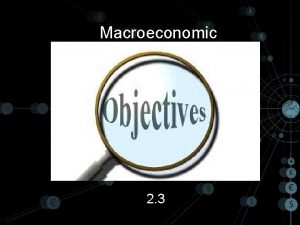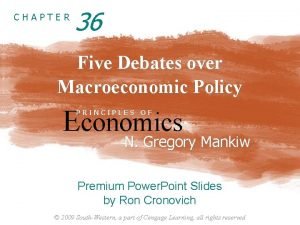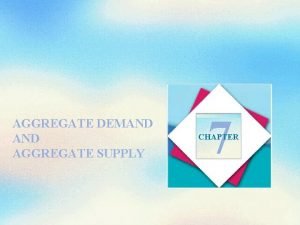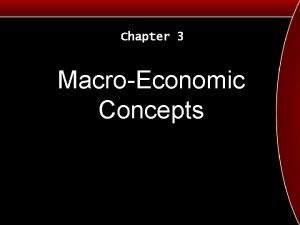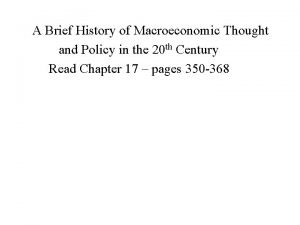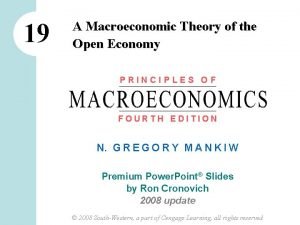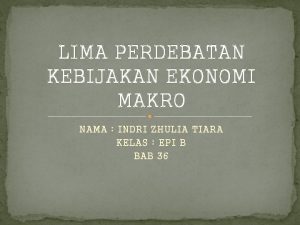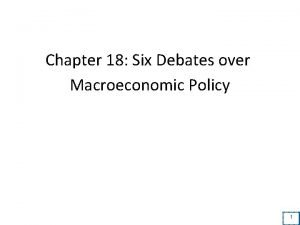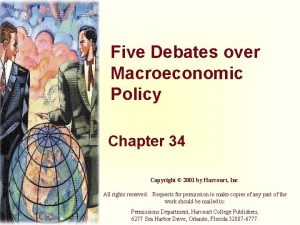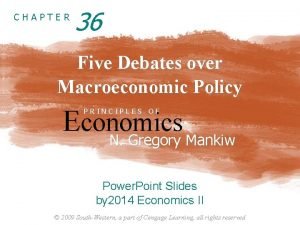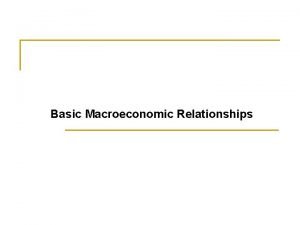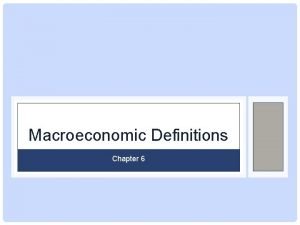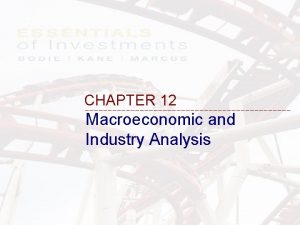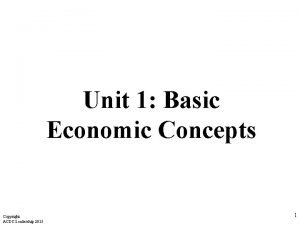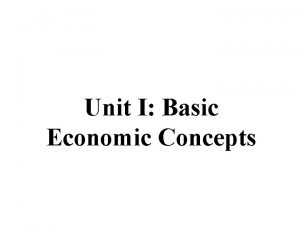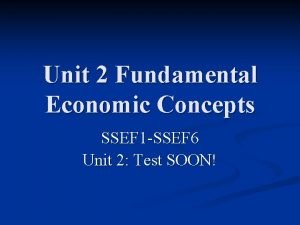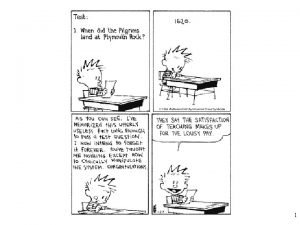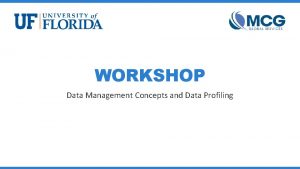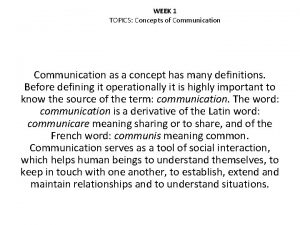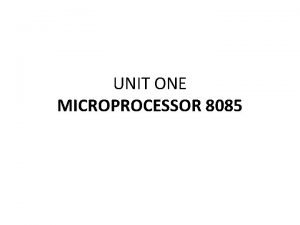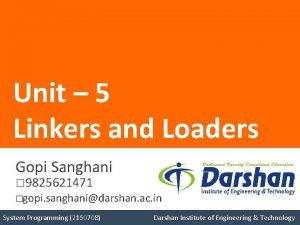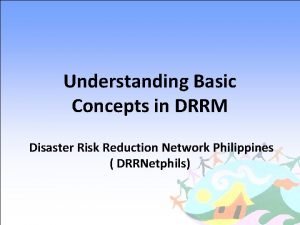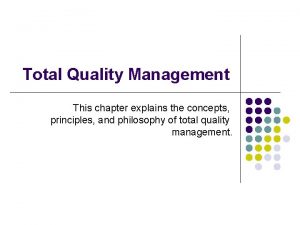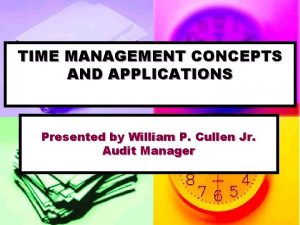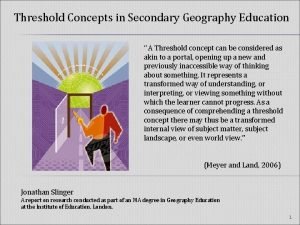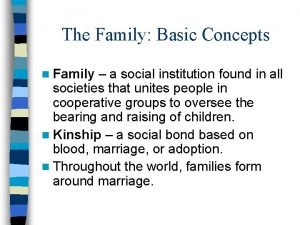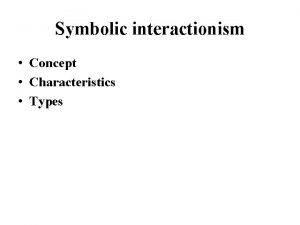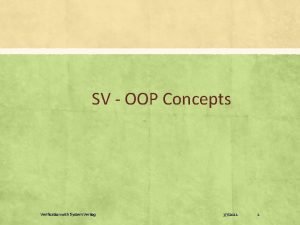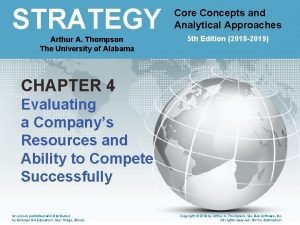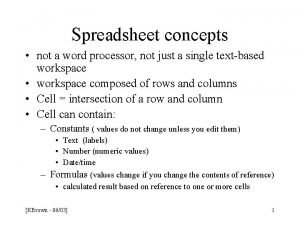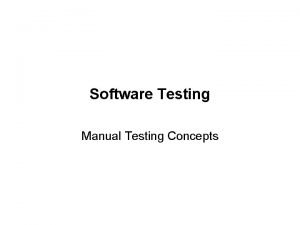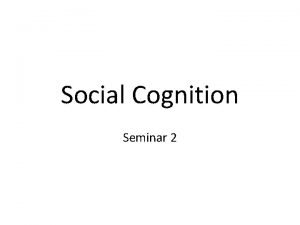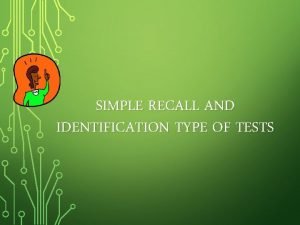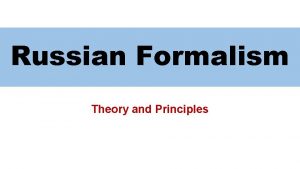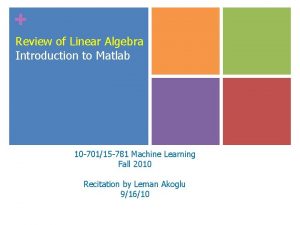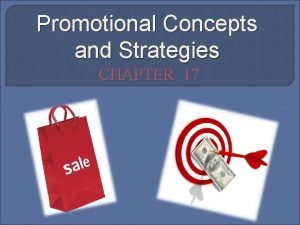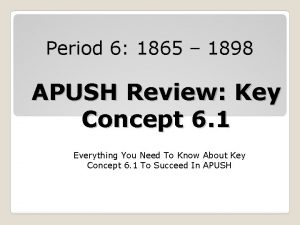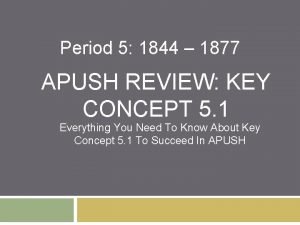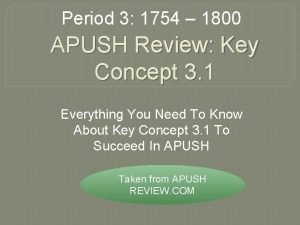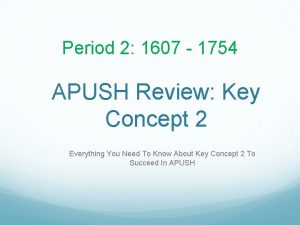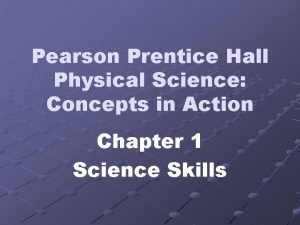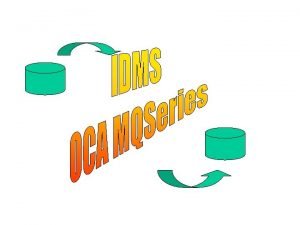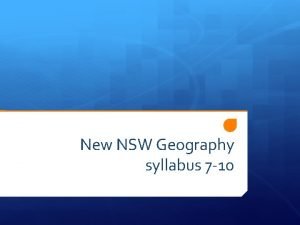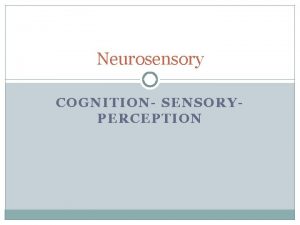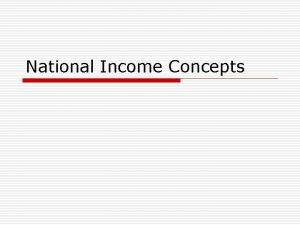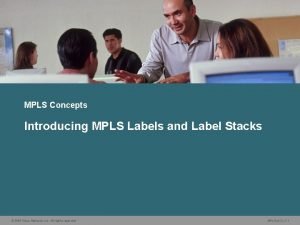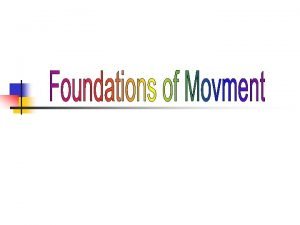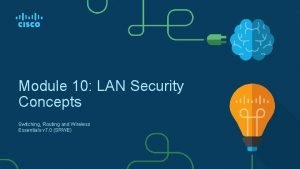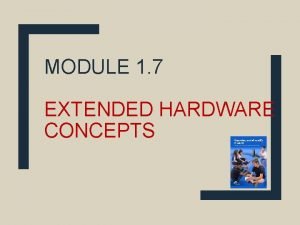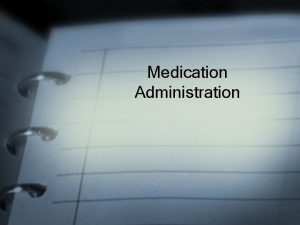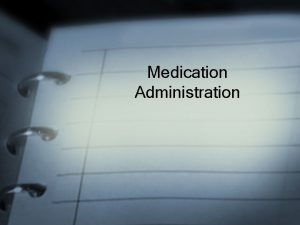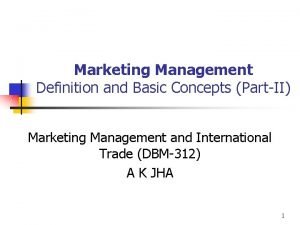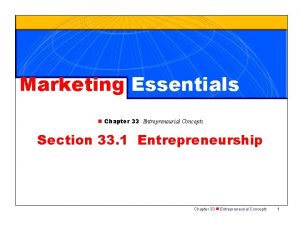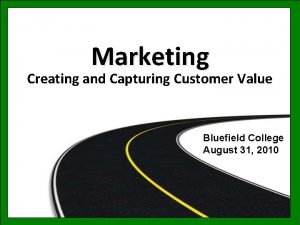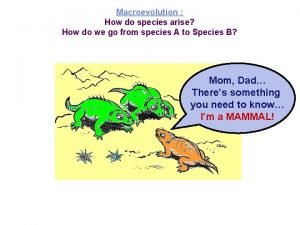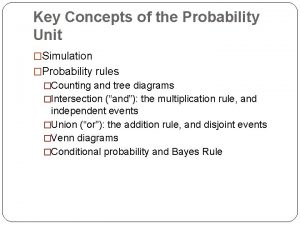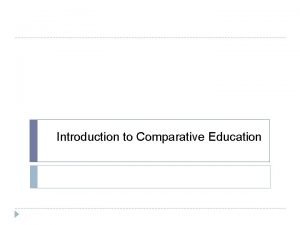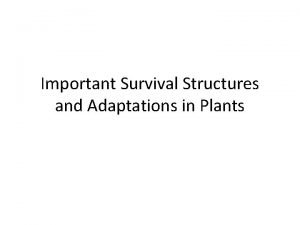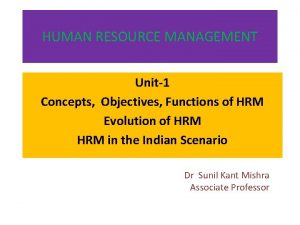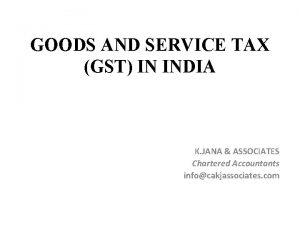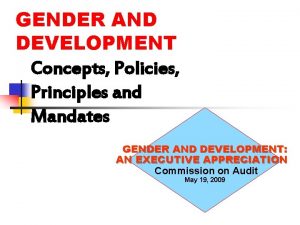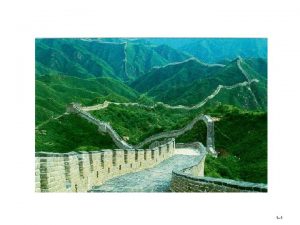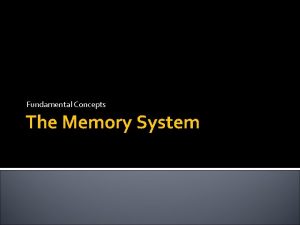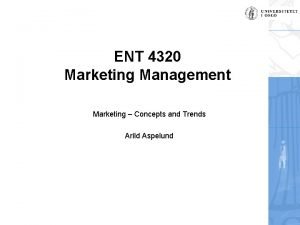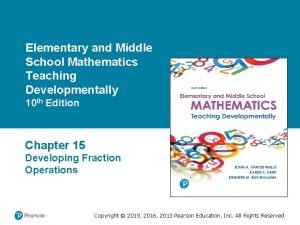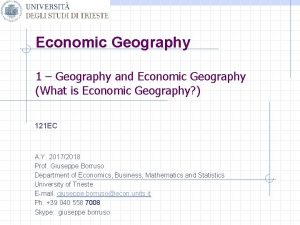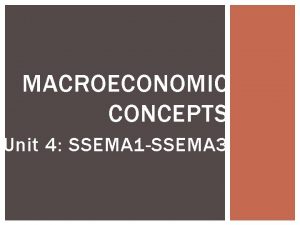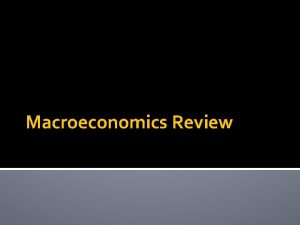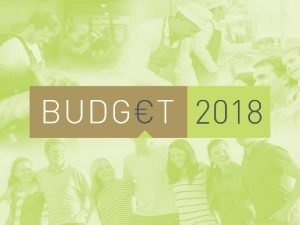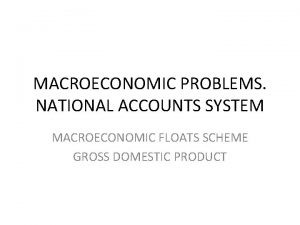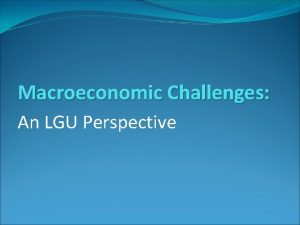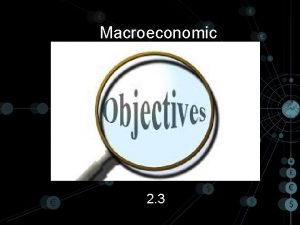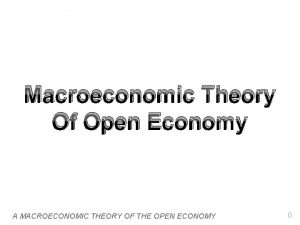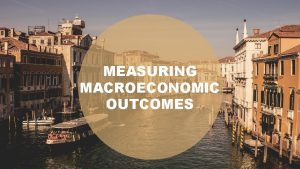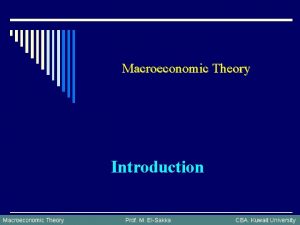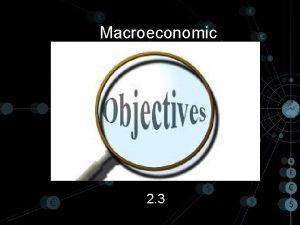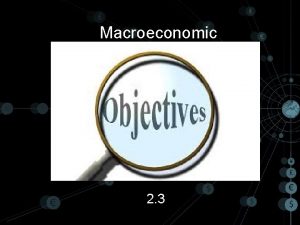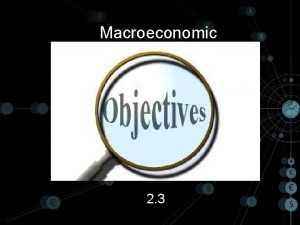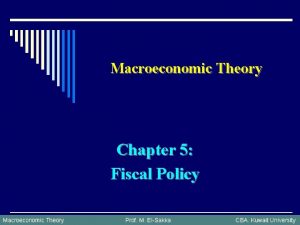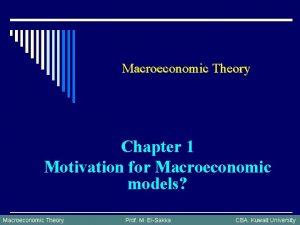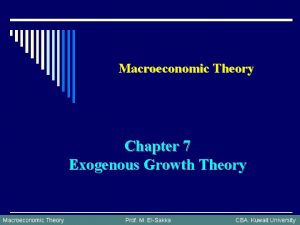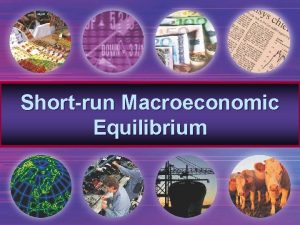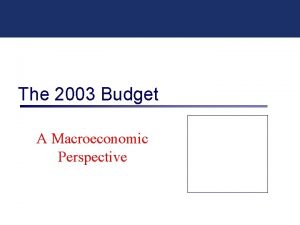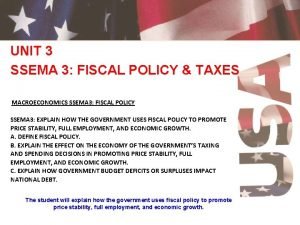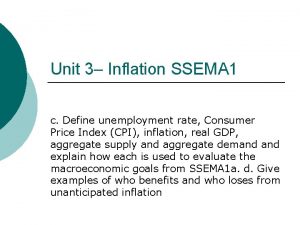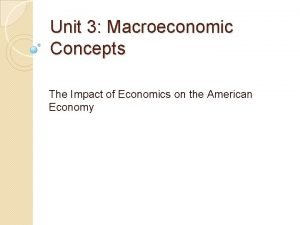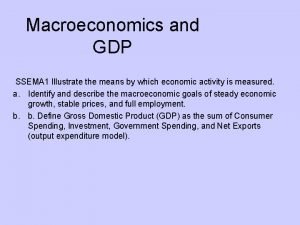Macroeconomic Concepts Unit 3 SSEMA 1 SSEMA 3

































































































- Slides: 97

Macroeconomic Concepts Unit 3: SSEMA 1 -SSEMA 3

Homework: • Reading/ Study Guide Chapters 816 –Due November 3, 2010


• Is the study of the economics of a nation. Macro examines the effects of events on the economy in aggregate (in total). It is important to understand how nations/economists measure and evaluate economic activity.

SSEMA 1 • The student will illustrate the means by which economic activity is measured.

SSEMA 1_a • Explain the overall levels of income, employment, and prices are determined by the spending and production decisions of households, businesses, and next exports.

Income • Total amount of income going to the consumer sector before individual income taxes are paid.

Fixed Income • Income does not change …. yet the prices of goods and services do change.

Employment • A job or an occupation held by individuals in the consumer sector which they get paid to do.

Net Exports • Are the amount of goods or resources a nation is exporting and selling, once one subtracts the amount of total imports from total exports


• Total Number of Exports-Total number of Imports = Net Exports

SSEMA 1_b. Define GROSS Domestic Product (GDP), economic growth, unemployment, Consumer Price Index (CPI), inflation, stagflation, and aggregate supply, and aggregate demand.

SSEMA 1_c • Explain how economic growth, inflation, and unemployment are calculated.

SSEMA 1_d • Identify structural, cyclical, and frictional unemployment.

GDP-

• Is the Total value of all final goods and services produced in a nation over a time period usually a year. The more final goods and services an economy produces, the healthier it is generally considered to be.

SSEMA 1_c economic growth calculation • GDP is equal to the total of all consumer spending, business investment, gov’t spending, and net exports.

GDP Calculation (economic growth) • GDP= C + I+G+Xn • C = consumer spending • I = Investment • G=Government Spending • Xn = Exports-Imports

Side Note……… • The reason we subtract our imports from our exports is this: The money other countries spend on our exports adds value to our economy, while the money we spend on goods imported from other countries takes money out of our economy.

Economic Growth • Sustained period which a nation’s total output of goods and services increases.

Unemployment


• State of working for less than one hour per week for pay or profit while being available and having made an effort to find a job during the past month.

SSEMA 1_c: Unemployment Rate = Number of people looking for work Number of people in labor force

Labor Force • To be counted in this calculation a person either has a job or is looking for one.

Structural Unemployment • Occurs when skills of the labor force do not match those that employers need. (SSEMA 1_d)

Frictional Unemployment • Occurs when people decide not to take a particular job because they are looking for a better job that suits their talents, needs, and desires. (SSEMA 1_d)

Seasonal Unemployment • Affects mainly people whose jobs depend on the weather (SSEMA 1_d)

Cyclical Unemployment • Occurs because of a downturn in the economy. (SSEMA 1_d)

Consumer Price Index (CPI)

• Is an economic Indicator • Measures Inflation • Measures monthly changes in the costs of goods and services by monitoring the prices of goods and services that are typically purchased by consumers.

CPI: Calculation Economists add up the total price of a “market basket” or typical items bought by an average family in a month. They compare this total price to the total price of the same items during a base period (the year before)

CPI = Cost of today’s Market Basket x 100 Cost of market basket in previous year (SSEMA 1_c)

Index is 100 which is the base year CPI= $1, 000 (2007) $960 (2006) X 100 = 1. 04 = 104 Which represents 4% increase.

Inflation • Refers to an increase in the average price of goods and services bought by the average consumer

Inflation Occurs • Consumer demand is high and/or supply is short • The Consumer Price Index is High

• Prices increase consumers get less for their money • The Money supply in an economy increases too quickly

Stagflation • If prices increase but the economy does not grow

• Problematic to correct because solutions that address inflation tend to make existing unemployment worse

• In individual markets, supply and Demand interact to establish prices. In the nation as a whole, aggregated supply and aggregated demand interact to determine whether the economy is growing or declining.

Aggregated Demand • Is the total amount of goods and services that all of the people in a an economy are willing to buy…the Aggregated Demand curve slopes downward


Aggregated Supply • Is the total amount of goods and services that all producers in an economy are willing and able to make

Two Aggregate Supply Curves

Short-Run Supply Curve • Producers make slightly more goods as prices increase and slightly less as prices decreases…The shortrun aggregate supply curve slopes generally upward.


Long-Run Aggregate Supply Curve • The total amount that any economy can produce (the real GDP) remains fairly constant, because a nation’s real GDP is limited by its resources. For this reason, the ALRSC is a straight vertical line.


SSEMA 1_e • Define the stages of the business cycle, as was recession and depression.

Business Cycle Ups and downs consisting of four parts Trough, expansions (recovery), peak, contraction

Business Cycle

Expansion to Recovery • The economy is growing leading to a recovery because this growth often occurs after a less prosperous period

• Gov’t spending programs, corporate tax breaks, increased investments or even a war increased demand for production can lead to a recovery.

Peak to prosperity. • Production is high, low unemployment, and wages increase. The peak only last for a little while as the economy comes down it enters…….

Contraction===Recession • Fall in production • High Unemployment, • Rising Interest Rates • Declining profits • Slowdown in capital investments • Demand falls as consumers stop buying goods

• Business sell less…they make less • Stop hiring • Lay off employees… increasing unemployment rates • …. if this occurs for more than six months the economy is experiencing a recession

Recession • A decline in the nation’s GDP and/or negative economic growth for a period of more than sixeight months. Eventually the economy hits it lowest point…a Trough.

Trough • High Unemployment • Low Economic Production • Falling Stock Prices • If it continues over a long period of time the economy can slip into a …. .

Depression • Is an extended period of time in which a nation’s economy slows severely, causing hardship for households, businesses and the government.

SSEMA 1_f • Describe the difference between the national debt and government deficits.

National Debt • Each time the government borrows money it adds to the national debt, the total amount of money owed by the federal government. • Is the sum of all past deficits plus interest.

Government Deficits • When the government spends more money in a fiscal year than it has brought in

SSEMA 2 • The Student will explain the role and function of the Federal Reserve System

In Plain English! • http: //www. fede ralreserveeducati on. org/resources /IPE/intro. htm

• http: //www. federalre serveeducation. org/

SSEMA 2 a: • Describe the Organization of the Federal Reserve System

• “The Fed” was established in 1914. To set Monetary Policy, in order to promote economic growth and full employment and to limit the impact of inflation and recessions.

• Make and enforce rules about what banks can and cannot do. • Control Reserves: cash available for withdrawals, rather than being invested. Bank reserves are held by the Fed itself and transferred to individual banks as needed.

• A system of 12 banks in different regions of the nation, each of which prints paper currency called Federal Reserve Notes.


• The Federal Reserve System is run by a Board of Governors, who are appointed by the U. S. President.

Federal Open Market Committee (FOMC) (Decides The Monetary Policy of the Fed) Holds the most power in regards to day monetary policy.


SSEMA 2 b • Define Monetary Policy

• Decisions of the Federal Reserve System and determine and/or regulate the money supply in the economy

SSEMA 2_c • Describe how the Federal Reserve uses the tools of monetary policy to promote price stability, full employment, and economic growth

Price Stability • The fed creates policies that help stabilize prices in the market and try to prevent inflation, stagflation results that can lead to a recession

Full Employment • All individuals that are actively seeking employment have a job or occupation. The fed helps in this process by lower interest rates and the discount rate to help businesses hire more people in the market.

Economic Growth • If there is more money circulating in the economy by the Fed’s policies, it can help promote growth thoughtout the entire economy.

Characteristics of Money • Any type of currency must be portable, durable, dividable, and limited in its availability

Open-Market Operations • (The sale or purchase of U. S. treasury bonds) to control the flow of money…loaning money to the gov’t

bonds a. k. a securities • Bonds- document issued by the gov’t for which a person pays a certain price now, in exchange for a higher fixed amount, called face value, later. (takes money out of the market).

• When The Fed sells securities (bonds), it lowers the money supply in hopes to fight inflations. • In the event of a recession the Fed will buy treasury bonds on the open market and congress will cut taxes.

• When the feds sell securities, bank reserves of money decrease as households and businesses purchase bonds rather than save their money in banks.

• Feds buy securities it is increasing the supply of money back into the economy, This causes interest rates to drop, spending increases, price level with increase, and more money is pumped into the economy.

Regulating Money Supply… • In a recession the Feds buy government securities and lower the discount rate. –Discount Rate- the interest rate it (gov’t) charges to other banks to lend them money.

SSEMA 3 The student will explain how the government uses fiscal policy to promote price stability, full employment, and economic growth.

• A. Define Fiscal Policy • B. Explain the government’s taxing and spending decisions


A. Fiscal Policy • The federal government’s decisions it makes about taxing and spending in order to promote economic growth and stability

• Any form of money the gov’t takes in or spend falls under the fiscal policy umbrella

Goal of Fiscal Policy • Price Stability • Economic Growth • Full Employment

b. Taxing & Spending Decisions

• Taxes- Revenue the government creates from individuals’ working wages.

• The Federal Reserve and Congress Both want to correct the economy the best combination in achieving this goal is through increasing government spending, sell treasure bonds, but taxes, and buy treasury bonds.

 Ssema
Ssema Macroeconomic objectives
Macroeconomic objectives Five debates over macroeconomic policy
Five debates over macroeconomic policy Macroeconomic equilibrium occurs:
Macroeconomic equilibrium occurs: Macroeconomics deals with:
Macroeconomics deals with: History of macroeconomic thought
History of macroeconomic thought A macroeconomic theory of the open economy
A macroeconomic theory of the open economy Six debates over macroeconomic policy
Six debates over macroeconomic policy Six debates over macroeconomic policy
Six debates over macroeconomic policy 5 debates over macroeconomic policy
5 debates over macroeconomic policy Five debates over macroeconomic policy
Five debates over macroeconomic policy Basic macroeconomic relationships
Basic macroeconomic relationships Macroeconomic definitions
Macroeconomic definitions Macroeconomic and industry analysis
Macroeconomic and industry analysis Unit 10, unit 10 review tests, unit 10 general test
Unit 10, unit 10 review tests, unit 10 general test Apush unit 2
Apush unit 2 Acdc leadership
Acdc leadership Unit 1: basic economic concepts answer key
Unit 1: basic economic concepts answer key Ssef price list
Ssef price list Ap microeconomics unit 1 basic economic concepts
Ap microeconomics unit 1 basic economic concepts Unit surplus dan unit defisit
Unit surplus dan unit defisit Hyp opp adj
Hyp opp adj English system conversion
English system conversion Algebra 2 unit 1 test answers
Algebra 2 unit 1 test answers Contoh soal perhitungan unit cost rumah sakit
Contoh soal perhitungan unit cost rumah sakit Unit process and unit operation
Unit process and unit operation Difference between unit process and unit operation
Difference between unit process and unit operation Kerangka konseptual standar akuntansi pemerintahan
Kerangka konseptual standar akuntansi pemerintahan Data management concepts
Data management concepts Concepts of communication
Concepts of communication Virtualization concepts
Virtualization concepts What is microprocessor 8085
What is microprocessor 8085 An overlay structured program contains
An overlay structured program contains Ra 10121
Ra 10121 Six basic concepts of tqm
Six basic concepts of tqm Time management concepts
Time management concepts Threshold concepts in geography
Threshold concepts in geography Complexive concept linguistics
Complexive concept linguistics Basic concepts of family
Basic concepts of family Evolution of computer architecture
Evolution of computer architecture Terminology and concepts
Terminology and concepts Symbolic interactionism concept
Symbolic interactionism concept Systemverilog oops concepts
Systemverilog oops concepts Strategy: core concepts and analytical approaches
Strategy: core concepts and analytical approaches Spreadsheet concepts
Spreadsheet concepts Software testing concepts
Software testing concepts Self fulfilling prohecy
Self fulfilling prohecy Recall example
Recall example Russian formalism theory
Russian formalism theory Key concepts examples
Key concepts examples Linear independence of vectors
Linear independence of vectors Tinka design
Tinka design Renewable source of energy definition
Renewable source of energy definition Promotional concepts and strategies
Promotional concepts and strategies Health promotion in nursing practice 7th edition
Health promotion in nursing practice 7th edition Provision of essential drugs
Provision of essential drugs Period 6 key concepts apush
Period 6 key concepts apush Anthony comstock apush
Anthony comstock apush Apush review.com
Apush review.com Apush key concepts period 2
Apush key concepts period 2 Prentice hall physical science concepts in action
Prentice hall physical science concepts in action Mq concepts
Mq concepts Polymorphism in oops
Polymorphism in oops What are the 7 geographical concepts
What are the 7 geographical concepts Interrelated concepts nursing
Interrelated concepts nursing Nnp calculation formula
Nnp calculation formula Mpls reserved labels
Mpls reserved labels Movement education wheel
Movement education wheel Stp manipulation attack
Stp manipulation attack Extended hardware concepts
Extended hardware concepts Medication administration 3 pretest
Medication administration 3 pretest Injectable medication administration pretest
Injectable medication administration pretest Selling concept definition
Selling concept definition Definition of marketing
Definition of marketing Chapter 33 entrepreneurial concepts answers
Chapter 33 entrepreneurial concepts answers An expanded model of the marketing process
An expanded model of the marketing process Types of speciation
Types of speciation Probability concepts in simulation
Probability concepts in simulation Relational concepts examples
Relational concepts examples Eai interface
Eai interface Apache spark concepts
Apache spark concepts Definitions of comparative education
Definitions of comparative education Basic marketing concepts
Basic marketing concepts Connecting the concepts angiosperm reproductive structures
Connecting the concepts angiosperm reproductive structures Concepts of hrm
Concepts of hrm Human genetics concepts and applications 10th edition
Human genetics concepts and applications 10th edition Hrm concepts
Hrm concepts Concept of gst
Concept of gst Gad goals
Gad goals Core concepts of management
Core concepts of management Basic concepts of memory
Basic concepts of memory Christian leadership concepts
Christian leadership concepts Objectives of facility layout planning
Objectives of facility layout planning Various marketing concepts
Various marketing concepts Kinematic concepts for analyzing human motion
Kinematic concepts for analyzing human motion Chapter 15 developing fraction concepts
Chapter 15 developing fraction concepts Middle level integration
Middle level integration Geography concepts
Geography concepts

